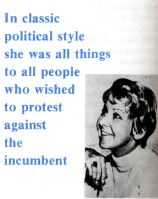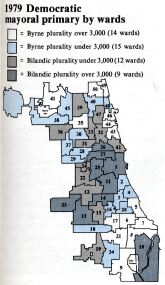 |
Home | Search | Browse | About IPO | Staff | Links |
 |
Home | Search | Browse | About IPO | Staff | Links |
Byrne's Victory: true grit and heavy snow
|
JANE BYRNE'S election as mayor of Chicago is a classic case of the right person being in the right place at the right time. The mix of elements contributing to her victory over Michael A. Bilandic was subtle and complex, but certainly comprehensible to knowledgeable observers of Chicago politics.
As we noted in our February 1979 Illinois Issues article, Chicago is an overwhelmingly Democratic city, but there are major divisions within the Democratic electorate the northwest side ethnics, the liberal independents, the blacks, the traditional inner-city organization wards and the rising southwest side bloc of organization wards. These divisions show up repeatedly in past election results to one degree or another depending on the issues and candidates in a particular year. In contested mayoral primaries, the endorsed candidate of the regular Democrats has only been able to triumph because he has faced more than one opponent. If one compares the endorsed candidate's vote versus his combined opposition, Byrne's victory becomes less surprising. Richard J. Daley in 1955 and Bilandic in 1977 obtained only about half the Democratic primary vote, as did Bilandic in 1979. Moreover, the turnout in 1979 (809,043) was only slightly higher than 1975 (801,442), although it was considerably above that in the 1977 special mayoral primary (720,883). The difference in 1979 was that Jane Byrne was Bilandic's only opponent. |
 |
Thus, the first important factor in Jane Byrne's triumph over the "machine" was that she was in a two-person race within a Democratic primary. Michael Bilandic's seeming invincibility in late 1978 actually worked against him, because it discouraged everyone but Byrne from mounting a challenge. Thus, Byrne was in a position to do what many had considered impossible -- to pull together the potential dissident groups and defeat the organization.
In December 1978, Don Rose, later to become Jane Byrne's chief strategist, appeared before our elections class at Governors State University and argued that the single most important issue that binds the Chicago machine together is race. In effect, that issue prevented potential antimachine constituencies such as southside blacks and northside Poles from uniting with the city's independents against the increasingly southwest side organization leadership. He concluded that some catastrophic event would occur sooner or later to unit them behind a single candidate who would then defeat the organization. Rose's prediction came true much sooner than even he would have guessed -- the event was snow, the time January 1979, and the candidate was Jane Byrne.
Without minimizing the strengths of Byrne as a candidate or the brilliant campaign she ran in the weeks preceding the Feburary 27 primary, Bilandic would still be mayor of Chicago if the city had not suffered an onslaught of ice, snow and bitter cold during January that was without precedent. The snow covered the city, and the divisive race issue was buried along with everything else.
The "city that works" stopped working and as snow-clogged streets remained impassable and uncollected garbage piled up in alleys, Bilandic seemed unable to cope with the problem. Byrne's television commercials, in which the grim-faced challenger huddled in heavy winter clothes against a background of snow, spoke to the frustration of Chicagoans with the terrible winter.
Thus the weather, of all things, was the key factor which unleashed a number of frustrations of Chicagoans and made Byrne a credible candidate. Byrne then captured the votes of independents on the lakefront who were protesting condominium conversions and sweetheart consultant deals with Ken Sain. She won the support of blacks who were angered by the closing of CTA stops in the black community, the slating of Bennett M. Stewart for congressman, the slighting of interim Mayor Wilson Frost, and the racial incident involving the sons of Bilandic's closest aide, Tom Donovan. She received the backing of many northwest siders who felt neglected by the Bilandic policy of consolidating power on the southwest side. Byrne also appealed to many other regular Democrats with their own reasons for opposing the incumbent mayor, notably John C. Marcin and Joseph G. Bertrand who were dumped from the citywide ticket by Bilandic.
Nevertheless, only the right candidate with the right campaign could have pulled off the upset. Byrne was a regular
8 / May 1979 / Illinois Issues
|
Democrat who requested slating from the organization and emphasized her close relationship to Mayor Daley throughout the campaign. She was also an outsider, a woman fighting the seeming corruption, incompetence and arrogance of those male, cigar-smoking backroom politicians in power! She formerly lived on the northwest side and was now residing in the near-north 42nd Ward. She attacked Police Supt. James O'Grady and the CTA to demonstrate her solidarity with unhappy black citizens. Byrne is Irish, the one ethnic group seemingly able to win support from all elements of the electorate. In short, in classic political style, she was all things to all people who wished to protest against the incumbent.
The shape of Byrne's victory coalition is depicted in the accompanying map, which shows the plurality obtained by Byrne and Bilandic in each of the 50 wards. Byrne carried 29 wards, 14 with a plurality over 3,000 votes. Of those 14, six are predominantly middle-class black, and six are "lakefront liberal" independent wards. These dozen have shown their willingness to oppose the regular candidate in the past; both Daley in 1975 (against Singer and New-house) and Bilandic in 1977 (against Pucinski and Washington) did poorly in these wards. Bilandic carried 21 wards, nine by a margin of 3,000 votes or more. Seven of these nine carried by 60 percent or more in both the 1975 and 1977 primaries and are among the most reliable organization wards. |

|
Looking at the results in terms of voting blocks, Byrne won 14 of 16 black wards, all seven independent "lake-front" wards, 12 of 17 "north of North Avenue" wards. Her other two victories came in wards with growing black populations, the 18th and 37th. Bilandic was largely confined to the oldest inner-city strongholds of the organization, slightly extended into the southwest side. The few exceptions to this pattern are probably attributable to the heroic efforts and personal popularity of such committeemen as Edward R. Vrdolyak (10th), Thomas C. Hynes (19th), and Edmund L. Kelly (47th) in outlying wards.
A detailed ward-by-ward analysis comparing Richard Daley's 1975 triumph over William S. Singer, Edward Hanrahan and Richard H. Newhouse with Byrne's defeat of Bilandic reveals the magnitude of the political shift in the Polish northside and black southside wards. The greatest percentage drop-off in the organization's vote occurred in Marcin's 35th Ward and Roman C. Pucinski's 41st Ward. These and other northside Polish wards had backed Pucinski against Bilandic in the 1977 primary, and they refused to return to the organization in 1979. Percentage drop-offs in the black wards were less than in the Polish wards because the previous two Democratic mayoral primaries had black candidates. However, the big story in the far southside black areas in 1979 was the margins they gave the machine challenger. For example, Byrne's crushing of Bilandic in the middle-class black 21st Ward was the second highest plurality for either candidate in the entire city.
Thus, Byrne's victory over Bilandic, while startling, was in fact a return to previous, established voting patterns in the city. Peripheral ward Democrats who for so long had been courted by Richard J. Daley revolted against the leadership of Bilandic. Thus, the incumbent was left with the traditional heart of the Democratic organization vote -- the less populated inner-city wards -- and the organization was outcounted.
Jane Byrne, realizing the fragility of her electoral alliance of protest groups and the difficulty of governing with such a coalition, moved quickly and effectively after the primary to cement her position as new leader of the regular Democrats. Her easy victory over Republican Wallace Johnson for the mayoralty on April 3 shows that some things don't change in Chicago the Republican cause is still hopeless.
Peter W. Colby and Paul Michael Green are professors of public service at Governors State University, Park Forest South. They team-teach a course on U.S. and Illinois elections.
9 / May 1979 / Illinois Issues
|
|